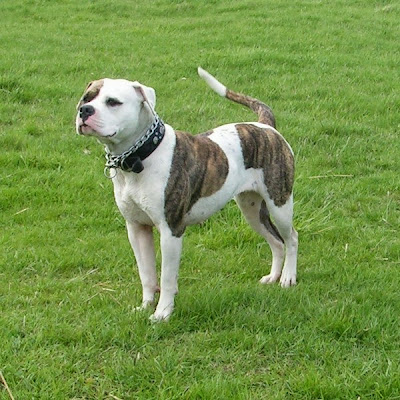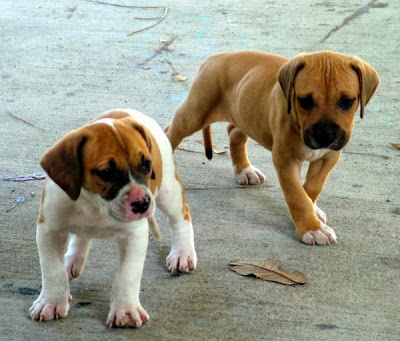You're looking to find the top dog insurance and I'm going to advise you on ways of finding the best dog insurance. So, first of all, well done for deciding to insure your dog. More and more owners are choosing to insure their dogs from the outset rather than risking an unsure future for their dogs, with the possibility of a sickness or injury which could be unaffordable and result in their dog having to be put down. Try telling that to your child.
You may be thinking, so why don't you just tell us what the best dog insurance policy is! I honestly wish that I could and that it were that simple. You must do your own research which will result in the top dog insurance policy for your circumstances and your dog's peculiarities.

There is a 3 stage process for selecting your dog's insurance plan. Research, Comparison, and Selection.
Research.
Probably the easiest way to research companies is on the internet. Here you can find details of policies, prices, and exclusions. Don't ignore other sources of information such as fellow dog owners, veterinarians, and kennels who could also be valuable sources of information. You will need to carry out a careful study of the current policies available. Try to be as exact as possible in your search in order to narrow down the search of all the plans available. Research details of deductibles, coverage, exclusions, details specific to your dog's breed, age and any existing or anticipated health problems, say from the lineage of the dog.
Dog Insurance Comparison.
Now that you have a shortlist of possible insurers,(at least three is best), the next stage is to compare them side by side. Be determined not to compare on cost alone. Each will have advantages and disadvantages. Do they all cover the same illnesses, injuries, services (diagnostics, surgery, hospitalisation)? Are there any exclusions? Does the policy cover cancer? Is your dog too old? Is your breed covered and if so, is it particularly well covered? Does the insurance offer pet insurance lifetime cover? Does the policy allow for your own choice of veterinarian? Does it cover wellness care? Not all of these considerations will have equal significance for your circumstances. Some may add cost and you may decide not to include them but they should all be considered in the comparison stage.
Top Dog Insurance Selection.
Now you will have the data to enable you to make your selection. Hopefully, one will stand out as the best dog insurance plan to meet your criteria. If cost is a deciding factor then you can play off the insurance companies against each other in order to get the best price. Otherwise, stick to what is best for you and your dog.
Once again, I congratulate you on deciding to ensure your dog has a healthy future, and I wish you all the best for selecting the top dog insurance.
Click here for more information, tips and resources to help you to find the top dog insurance [http://www.mypetinsurancecomparison.net]
Article Source: http://EzineArticles.com/5677927
The pug is a toy dog with a wrinkly, short-muzzled face and curled tail. The breed has a fine, glossy coat that comes in a variety of colors, although often black or fawn, and a compact square body with well-developed muscles. Known in ancient China as lo-sze, pugs as breeding animals may have contributed to the English Bulldog, the modern Pekingese and the King Charles Spaniel. Pugs were brought from China to Europe in the seventeenth century and were popularized in Western Europe by the House of Orange of the Netherlands, and the House of Stuart. Pugs remain popular into the twenty-first century, with some famous celebrity owners. A pug was judged Best in Show at the World Dog Show in 2004.

Physical characteristics
While the pugs that are depicted in eighteenth century prints tend to be long and lean,modern breed preferences are for a square cobby body, a compact form, a deep chest, and well-developed muscle. Their smooth and glossy coats can be fawn, apricot fawn, silver fawn, or black. The markings are clearly defined and there is a trace of a black line extending from the occiput to the tail. The tail normally curls tightly over the hip.
Pugs have two distinct shapes for their ears, "rose" and "button". "Rose" ears are smaller than the standard style of "button" ears, and are folded with the front edge against the side of the head. Breeding preference goes to "button" style ears.
Pugs' legs are very strong, straight, of moderate length, and are set well under. Their shoulders are moderately laid back. Their ankles are strong, their feet are small, their toes are well split-up, and their nails are black. The lower teeth normally protrude further than their upper, resulting in an under-bite.
The breed is often described as multum in parvo, or "much in little", alluding to the pug's remarkable personality, despite its small size. Pugs are strong willed but rarely aggressive, and are suitable for families with children. The majority of the breed is very fond of children and sturdy enough to properly play with them. Depending on their owner's mood, they can be quiet and docile but also vivacious and teasing.
Health problems
Since pugs lack longer snouts and prominent skeletal brow ridges, they are susceptible to eye injuries such as proptosis, scratched corneas, and painful entropion. They also have compact breathing passageways, leaving many prone to breathing difficulties or unable to efficiently regulate their temperature through evaporation from the tongue by panting. A pug's normal body temperature is between 101 °F (38 °C) and 102 °F (39 °C). If this temperature rises to 105 °F (41 °C), oxygen demand is greatly increased and immediate cooling is required. If body temperature reaches 108 °F (42 °C), organ failure can occur.
Pugs that live a mostly sedentary life can be prone to obesity, though this is avoidable with regular exercise and a healthy diet. The median life span of pugs is 11 years, which is in line with other breeds of the same size.
Data refer : http://en.wikipedia.org/wiki/Pug_dog


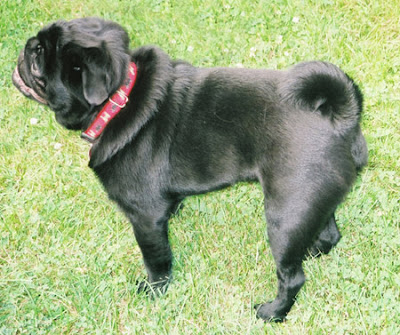



Have you ever stopped to think that the top dog foods on the market may be, in fact, bad for your beloved dog?
If you are like most people, no, you haven't. Humans, like dogs, are very trusting in their nature. We see, read, and hear all the ads that the producers of the top dog foods put out, and we believe them? Why?
1.) Because we just do
2.) We can't understand the labels that are on the bags or cans of any of the generic or even major brands of top dog foods.
Now, not all dog food companies produce unhealthy dog food. But, if you actually did the research on it, you would probably find that the vast majority of the dog foods are not what they really should be.

Here are some reasons why:
1.) The dog food label may say that the food contains the essential nutrients for your dog. However, this is misleading. Depending on who you talk to, there may be 30 or 40 essential nutrients, but in many of the top dog foods, you are lucky to get maybe 10.
So, yes your dog food has the essential nutrients, but only a small percentage of them.
2.) Dog foods are loaded with preservatives so they don't spoil so quickly.
We can understand how preservatives affect our dogs if we look at humans and the studies done on preservatives and dieting. It is common knowledge that most dieticians say to avoid highly processed foods with a lot of preservatives. Why? Because too much is unhealthy.
High amounts of preservatives in dog foods, when consumed daily, store themselves in the dog's body and eventually start to destroy it, causing weakened and unhealthy pets susceptible to countless disorders and diseases.
3.) Labels are often misleading when they say the food is chemical and preservative free.
You may think - how could this be. Simply stated, dog food producers don't make all the ingredients themselves. They might not add any special chemicals, but when they purchase an ingredient from some other company, it may very well have the chemicals and preservatives already added in.
4.) All proteins are not created equal.
Many manufacturers state that their food contains proteins necessary for your dog. But there are different kinds of proteins and some are better than others, so which are in your dog food? The good ones or the bad ones?
5.) You might agree that this happens in the generic dog foods, but it probably happens in the brands of top dog foods also - and that is some of the ingredients are ..., well, they are too disgusting to mention here. You can find what these ingredients are by looking on the net or simply keep reading. But believe me. They are horrific and not good for your dog. We humans would never consider eating them!
In summary, you have just read 5 facts to consider when purchasing name-brand top dog foods or cheap generic brands of dog food. All of these facts have a major impact on the health and longevity of your dog.
Your dog's health and livelihood are based upon what it eats. A good diet will increase your dog's life, and give him better health, a better coat of hair, better teeth, a better character, a better disposition, and many many more benefits.
So the next time you are out shopping, don't just automatically buy one of the top dog foods product, but read the label and start to understand what is really in the food you are feeding your dog.
Lastly, please remember that the producers of the top dog foods do not necessarily have the health of your dog as their number one interest.
To learn how to improve the health & longevity of your dog, and, get 5 free simple things that you must do to protect your dog from death by disease & extend her life by years, please visit. http://www.lomist.com/Top_Dog_Foods_a.html
Article Source: http://EzineArticles.com/288435
Newfoundlands ('Newfs', 'Newfies') have webbed feet and a water-resistant coat.[4] Males normally weigh 60–70 kg (130–150 lb), and females 45–55 kg (100–120 lb), placing them in the "Giant" weight range but some Newfoundland dogs have been known to weigh over 90 kg (200 lb) - and the largest on record weighed 120 kg (260 lbs) and measured over 6 feet (1.82 m) from nose to tail, ranking it among the biggest Molossers. They may grow up to 22–28 inches (55–71 cm) tall at the shoulder.

The American Kennel Club (AKC) standard colors of the Newfoundland dogs are: black, brown, gray, beige and Landseer (white dog with black markings) Other colors are not rare, and not recommended because of breeding double recessive genes; The Kennel Club (KC) permits only black, grey, brown, and landseer; the Canadian Kennel Club (CKC) permits only black and landseer. Contrary to popular belief The Landseer is named after the artist Sir Edwin Henry Landseer, who featured them in many of his paintings. AKC, CKC, and KC all treat Landseer as part of the breed. Fédération Cynologique Internationale (FCI) consider the ECT Landseer to be a separate breed. It is a taller, more narrow white dog with black markings not bred with a Newfoundland.
The Newfoundland's extremely large bones give it mass, while its large musculature gives it the power it needs to take on rough ocean waves and powerful tides. These dogs have great lung capacity for swimming extremely long distances, and a thick, oily and waterproof double coat which protects them from the chill of icy waters. The droopy lips and jowls make the dog drool. In the water, the dog's massive webbed paws give it maximum propulsion. The swimming stroke is not an ordinary dog paddle. Unlike other dogs, the Newfoundland moves its limbs in a down-and-out motion, which can be seen as a modified breaststroke.[citation needed] This gives it more power with every stroke.
The Newfoundland dog is legendary for its calm and docile nature and its strength. They are highly loyal and make ideal working dogs. It is for this reason that this breed is known as "the gentle giant". International kennel clubs generally describe the breed as having a sweet temper.It typically has a deep bark, and is easy to train if started young. It is wonderfully good with children, but because of their size at a very young age, small children could get accidentally leaned on and knocked down. The breed was memorialized in "Nana," the beloved dog guardian in Peter Pan. The Newfoundland in general is good with other animals, but their size can create problems if not trained.
Data refer : http://en.wikipedia.org/wiki/Newfoundland_(dog)
Labradors are relatively large, with males typically weighing 29 to 41 kg (64 to 90 lb) and females 25 to 32 kg (55 to 71 lb). Labradors weighing close to or over 100 lb (45 kg) are considered obese or having a major fault under American Kennel Club standards, although some Labradors weigh significantly more.[18] The majority of the characteristics of this breed, with the exception of colour, are the result of breeding to produce a working retriever.

As with some other breeds, the Conformation (typically "English", "show" or "bench") and the Field (typically "American" or "working") lines differ, although both lines are bred in both countries. In general, however, Conformation Labradors tend to be bred as medium-sized dogs, shorter and stockier with fuller faces and a slightly calmer nature than their Field counterparts, which are often bred as taller, lighter-framed dogs, with slightly less broad faces and a slightly longer nose; however Field Labradors should still be proportional and fit within AKC standards. With field Labradors, excessively long noses, thin heads, long legs and lanky frames are not considered standard. These two types are informal and not codified or standardised; no distinction is made by the AKC or other kennel clubs, but the two types come from different breeding lines. Australian stock also exists; though not seen in the west, they are common in Asia. These dogs are also very good with children.
The breed tends to shed hair twice annually, or regularly throughout the year in temperate climates.Some Labradors shed considerably; however, individual Labradors vary.Labrador hair is usually fairly short and straight, and the tail quite broad and strong. The webbed toes of the Labrador Retriever make them excellent swimmers. The webbing between their toes can also serve as a "snowshoe" in colder climates and keep snow from balling up between their toes- a condition that can be painful to other breeds with hair between the toes. Their interwoven coat is also relatively waterproof, providing more assistance for swimming.
There is a great deal of variety among Labradors. The following characteristics are typical of the conformation show bred (bench-bred) lines of this breed in the United States, and are based on the AKC standard.Significant differences between UK and US standards are noted.
Size: Labradors are a relatively large breed. They should be as long from the withers to the base of the tail as they are from the floor to the withers. Males should stand 22.5 to 24.5 inches (57 to 62 cm) tall at the withers and weight 65 to 80 lb (29 to 36 kg). Females should stand 21.5 to 23.5 inches (55 to 60 cm) and weigh 55 to 70 lb (25 to 32 kg). By comparison under UK Kennel Club standards, height should be 22 to 22.5 inches (56 to 57 cm) for males, and 21.5 to 22 inches (55 to 56 cm) for females.
Coat: The Lab's coat should be short and dense, but not wiry. The coat is described as 'water-resistant' or more accurately 'water-repellent' so that the dog does not get cold when taking to water in the winter. That means that the dog naturally has a slightly dry, oily coat. Acceptable colours are black, yellow (ranging from ivory or creme to fox red), and chocolate.
Head: The head should be broad with a pronounced stop and slightly pronounced brow. The eyes should be kind and expressive. Appropriate eye colours are brown and hazel. The lining around the eyes should be black. The ears should hang close to the head and are set slightly above the eyes.
Jaws: The jaws should be strong and powerful. The muzzle should be of medium length, and should not be too tapered. The jaws should hang slightly and curve gracefully back.
Body: The body should be strong and muscular with a level top line.
The tail and coat are designated "distinctive [or distinguishing] features" of the Labrador by both the Kennel Club and AKC.The AKC adds that "true Labrador Retriever temperament is as much a hallmark of the breed as the 'otter' tail."
Colour

Labrador Retrievers are registered in three colours:black (a solid black colour), yellow (anything from the colour that some breeders sell as white or cream to "fox-red"), and chocolate (medium to dark brown). Some dogs are sold as "silver" pure-bred Labradors, but purity of those bloodlines is currently under dispute. Major kennel clubs around the world allow Silver Labradors to be registered, but not as 'Silver'. The Kennel Club (England) requires that they be registered as 'Non-recognised'. The parent club for the Labrador Retriever in the USA (the LRC) states publicly that 'There is no genetic basis for the silver gene in Labradors'.Occasionally Labradors will exhibit small amounts of white on their chest, paws or tail, and rarely a purebred Lab will exhibit brindling (stripes) or tan points similar to a Rottweiler.These markings are a disqualification for show dogs but do not have any bearing on the dog's temperament or ability to be a good working or pet dog.
Puppies of all colours can potentially occur in the same litter. Colour is determined primarily by three genes. The first gene (the B locus) determines the density of the coat's eumelanin pigment granules, if that pigment is allowed: dense granules result in a black coat, sparse ones give a chocolate coat. The second (E) locus determines whether the eumelanin is produced at all. A dog with the recessive e allele will produce only phaeomelanin pigment and will be yellow regardless of its genotype at the B locus. The genes known about previously have had their number increased by the introduction of the K locus, where the dominant "black" allele KB is now known to reside.Black or chocolate Labradors therefore must have the KB allele. Yellow Labradors are determined at the E locus, so the K locus is irrelevant in determining their colour. Variations in numerous other genes control the subtler details of the coat's colouration, which in yellow Labradors varies from white to light gold to a fox red. Chocolate and black Labradors' noses will match the coat colour.
According to a 2011 study, 13 out of 245 Labradors studied were heterozygous for the M264V mutation responsible for the melanistic mask, and one was homozygous. Within the breed, this trait is not visible.
Data refer: http://en.wikipedia.org/wiki/Labrador_Retriever

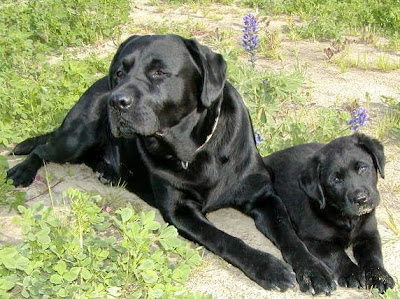

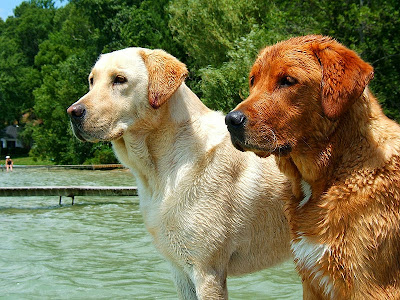

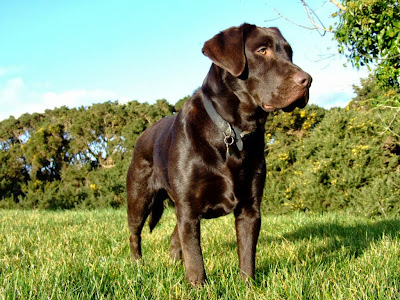


The Great Dane combines, in its regal appearance, dignity, strength and elegance with great size and a powerful, well-formed, smoothly muscled body. It is one of the giant working breeds, but is unique in that its general conformation must be so well balanced that it never appears clumsy, and shall move with a long reach and powerful drive.The Great Dane is a short haired breed with a strong galloping figure.

In the ratio between length and height, the Great Dane should be square. The male dog should not be less than 30 in (76 cm) at the shoulders, a female 28 in (71 cm). Danes under minimum height are disqualified.
From year to year, the tallest living dog is typically a Great Dane. Previous record holders include Gibson, Titan and George however, the current record holder is a black Great Dane named Zeus who stands 112 cm (44 in) at the shoulder.He is also the tallest dog on record (according Guinness World Records),[42] beating the previous holder who was a blue Great Dane named George, who stood 110 cm (43 in) at the shoulder.
The minimum weight for a Great Dane over eighteen months is 120 lb (54 kg) for males, 100 lb (45 kg) for females.Unusually, the American Kennel Club dropped the minimum weight requirement from its standard.The male should appear more massive throughout than the female, with a larger frame and heavier bone.
Great Danes have naturally floppy, triangular ears. In the past, when Great Danes were commonly used to hunt boars, cropping of the ears was performed to make injuries to the dogs' ears less likely during hunts. Now that Danes are primarily companion animals, cropping is sometimes still done for traditional and cosmetic reasons. In the 1930s when Great Danes had their ears cropped, after the surgery two devices called Easter Bonnets were fitted to their ears to make them stand up.Today, the practice is common in the United States but much less common in Europe. In some European countries such as the United Kingdom, Ireland, Denmark, Germany, parts of Australia, and in New Zealand, the practice is banned, or controlled to only be performed by veterinary surgeons.
Coat colors
There are six show-acceptable coat colors for Great Danes:
- Fawn: The color is yellow gold with a black mask. Black should appear on the eye rims and eyebrows, and may appear on the ears.
- Brindle: The color is fawn and black in a chevron stripe pattern. Often also they are referred to as having a tiger-stripe pattern.
- Blue: The color is a pure steel blue. White markings at the chest and toes are not desirable and considered faults.
- Black: The color is a glossy black. White markings at the chest and toes are not desirable and considered faults.
- Harlequin: The base color is pure white with black torn patches irregularly and well distributed over the entire body; a pure white neck is preferred. The black patches should never be large enough to give the appearance of a blanket, nor so small as to give a stippled or dappled effect. Eligible, but less desirable, are a few small grey patches (this grey is consistent with a Merle marking) or a white base with single black hairs showing through, which tend to give a salt and pepper or dirty effect. (Have the same link to deafness and blindness as Merle and white danes.)
- Mantle (in some countries referred to as Bostons due to the similar coloration and pattern as a Boston Terrier): The color is black and white with a solid black blanket extending over the body; black skull with white muzzle; white blaze is optional; whole white collar preferred; a white chest; white on part or whole of forelegs and hind legs; white tipped black tail. A small white marking in the black blanket is acceptable, as is a break in the white collar
Other colors occur occasionally but are not acceptable for conformation showing, and they are not pursued by breeders who intend to breed show dogs. These colors include white, fawnequin, brindlequin, merle, merlequin, blue merle, fawn mantle, and others. Some breeders may attempt to charge more for puppies of these "rare" colors. However, the breeding of white and merle Danes is particularly controversial, as these colors may be associated with genes that produce deafness. Although they cannot be shown, white or merle Danes can usually still be registered as pedigree dogs.
Temperament
The Great Dane's large and imposing appearance belies its friendly nature. The breed is often referred to as a "gentle giant".[1] Great Danes are generally well disposed toward other dogs, other non-canine pets, and familiar humans. They generally do not exhibit extreme aggressiveness or a high prey drive.[46] The Great Dane is a very gentle and loving animal and with the proper care and training is great around children, especially when being raised with them. However, if not properly socialized a Great Dane may become fearful or aggressive towards new stimuli, such as strangers and new environments.
Great Danes are a breed recommended for families provided that they get trained early and onwards, regarded by animal experts due to their preference for sitting on and leaning against owners as 'the world's biggest 'lapdog.
Data refer : http://en.wikipedia.org/wiki/Great_Dane







The Airedale Terrier (often shortened to "Airedale") is a breed of the terrier type that originated in Airedale, a geographic area in Yorkshire, England. It is traditionally called the "King of Terriers" because it is the largest of the terrier breeds. Bred from a Black and Tan Terrier and an Otterhound, the breed has also been called the Waterside Terrier, because it was bred originally to hunt otters in and around the valleys of the River Aire which runs through Airedale. In the United Kingdom this breed has also been used as a police dog.

The Airedale is the largest of the British Terriers. They weigh 25–30 kilograms (55–66 lb) and have a height at the withers of 58–61 centimetres (23–24 in) for dogs, with females slightly smaller.The American Kennel Club standard specifies a smaller dog. Larger Airedales, up to 55 kilograms (121 lb) can be found in North America. They are often called "Oorangs." This was the name of a kennel in Ohio in the early 1900s.
The Airedale has a medium-length black and tan coat with a harsh topcoat and a soft undercoat. They are an alert and energetic breed, "not aggressive but fearless."[1] It has been claimed that the large "hunting" type or Oorang Airedales are more game than the smaller "show" type Airedales. The large type are usually used for big game hunting and as family guardians or as pets, but usually do poorly in AKC conformation shows. This larger type is also significantly more prone to Hip Dysplasia than the standard Airedales.
The Airedale can be used as a working dog and also as a hunting dog. Airedales exhibit some herding characteristics as well, and have a propensity to chase animals. They have no problem working with cattle and livestock. However, an Airedale that is not well trained will agitate and annoy the animals.
The Airedale Terrier, like most Terriers, has been bred to hunt independently. As a result, the dog is very intelligent, independent, strong-minded, stoic, and can sometimes be stubborn. If children and Airedale are both trained correctly, Airedales can be an excellent choice for a family dog. Airedales can do well with cats and other small animals, especially when they are raised with them.
Albert Payson Terhune wrote of the Airedale: "Among the mine-pits of the Aire, the various groups of miners each sought to develop a dog which could outfight and outhunt and outthink the other miner's dogs. Tests of the first-named virtues were made in inter-mine dog fights. Bit by bit, thus, an active, strong, heroic, compactly graceful and clever dog was evolved – the earliest true form of the Airedale.
He is swift, formidable, graceful, big of brain, an ideal chum and guard. ....To his master he is an adoring pal. To marauders he is a destructive lightning bolt."
The Airdale can become aggressive, especially if he is systematically trained for that. Even so, it is not generally easy to instill aggression. Airdales usually relate to the world around them "without a stone in the bosom", they are too honest and dignified. This is a real beauty of the Airdale Terrier - strong, brave, full of curiosity and with a positive attitude.
Data refer : http://en.wikipedia.org/wiki/Airedale_Terrier




"The origin of the English mastiff is so lost in the mists of antiquity, that no positive assertions concerning it should be made. It is evident that dogs with his characteristics existed in Britain when the Romans first landed there. They speak of them as "the broadmouthed dogs of Britain." Whether these were of the mastiff or bull-dog type, or whether the two breeds have the same origin, cannot be determined. Much written on this subject is necessarily pure conjecture; consequently we need only concern ourselves with the immediate progenitors of the mastiff, and that dog as he exists to-day.
Of all the known canine races the mastiff is the largest and eminently the most massive. Exceptional specimens of the St. Bernard, the boar-hound, and the Siberian blood-hound may exceed in height and weight the average of large mastiffs; but these examples are so rare as not to materially modify the assertion of the superiority of the proportions of the mastiff.
The distinguishing marks of this breed are size, massiveness, dignity, and majesty of appearance. Twenty-eight to thirty-one inches may be accepted as a good average height at the shoulders. The girth of the chest should never be less than one-third more than the height. The body should be long and well filled out, without any approach to the tucked-up loin of the hound. This is very objectionable. The legs should be straight, with immense bone and muscle; the feet round and close; the tail thick at the root, tapering evenly to a point, and not extending much below the hocks. The head is now the great point with fanciers. It should be broad across the skull, flat to the eyebrow, well indented up the center, with small, close-lying ears, partly erected when attention is aroused; the muzzle broad, short and square-looking, as though it had been sawed off. Fashion changes much in this direction. The great show dogs of ten years since would stand no chance in a modern competition. A very much shorter, blunter muzzle is now the standard. Whether the dog of to-day has really gained in appearance by his shorter muzzle is certainly open to doubt. The grand preeminent qualities of the mastiff are shown in his affectionate, true, noble, faithful disposition and even temper. He is above all others the watch-dog. Bred for generations for this purpose, his impulses lead him exclusively in this direction - to watch and guard, and to repulse trespassers within his precinct. He accomplishes this end by a resolute and imposing bearing, never resorting to force until repeated gentle warnings have been ignored. Menace to the person of his master the mastiff fiercely resents. His mode of attack is to spring upon an evil-doer, knock him down, and subdue him with significant growls. He seldom bites, even under the severest provocation. To guard those living in isolated localities, as a protector of women and children, he is without a peer - the sturdy and faithful watchman of the home. W. Wade "
With a massive body, broad skull and head of generally square appearance, it is the largest dog breed in terms of mass. Though the Irish Wolfhound and Great Dane are taller, they are not nearly as robust.
The body is large with great depth and breadth, especially between the forelegs, causing these to be set wide apart. The AKC standard height (per their website) for this breed is 30 inches (76 cm) at the shoulder for males and 27.5 inches (70 cm) (minimum) at the shoulder for females. A typical male can weigh 150–250 pounds (68–110 kg), a typical female can weigh 120–200 pounds (54–91 kg), with show specimens tending towards the upper ranges.
The Mastiff should at all stages of development show the breed characteristics of massiveness and sound, if cumbersome, movement.
The Mastiff is a particularly large dog demanding correct diet and exercise. Excessive running is not recommended for the first two years of the dog's life. However, regular exercise must be maintained throughout the dog's life in order to discourage slothful behavior and to prevent a number of health problems. A soft surface is recommended for the dog to sleep on in order to prevent the development of calluses, arthritis, and hygroma (an acute inflammatory swelling). Due to the breed's large size, puppies may potentially be smothered or crushed by the mother during nursing. A whelping box, along with careful monitoring can prevent such accidents. The average lifespan of the Mastiff is about 7 years although it's not uncommon for some to live to 10–11 years.
Data refer: http://en.wikipedia.org/wiki/English_Mastiff






The American Bulldog is a descendant of the English Bulldog, imported to the American South to catch livestock and protect plantations, and used in the North to fight off feral pigs. The English Bulldog (or simply ‘Bulldog’) was bred in England in the 1500’s for bull baiting, a popular gambling ‘sport’ in which one or more dogs were matched up against a chained bull (or bear). These dogs were bred for sheer fighting capacity, and they were famed for latching onto their prey with an iron jaw which they refused to release—they could even suffocate opponents this way. The American Bulldog is perhaps the most faithful strain to the English Bulldog as it was imported to America before the English Bulldog was crossed with the Pug during the Industrial Revolution. American Bulldogs are generally divided into two strains: the Classic American Bulldog, also known as the ‘Johnson’ (after its breeder) or ‘Bully’, and the Standard American Bulldog, also known as the Scott (after its breeder) or ‘Performance’.

The American bulldog is a stocky, well built, strong-looking dog, with a large head and a muscular build. Its coat is short and generally smooth. The breed is a light to moderate shedder; however, they should be brushed on regular basis. Colors, while historically predominantly white with patches of red, black, or brindle, have grown in recent years to include many color patterns including black, red, brown, fawn, and all shades of brindle. The color conformation is quite varied, but solid black or any degree of merle is considered a cosmetic fault, and a blue color is a disqualification by the NKC Breed Standard. Black pigmentation on the nose and eye rims is preferred, with only some pink allowed. Eye color is usually brown, but heterochromia also occurs, although considered a cosmetic fault. American Bulldogs can be droolers; this varies and is more prevalent in the Bully type, which is generally a larger, heavier dog with a shorter muzzle. Standard or Performance types are generally more athletic with longer muzzles and a more square head. It is important to note that many modern American Bulldogs are a combination of the two types usually termed "hybrid." In general, American Bulldogs weigh between 27 to 54 kg (60 to 120 lb) and are 52 to 70 cm (20 to 28 in) at the withers, but have been known to greatly exceed these dimensions, especially in the "out of standard," nonworking stock.
American Bulldogs are typically confident, social, and active dogs that are at ease with their families. It is not uncommon for an American Bulldog to require a high level of attention due to their highly emotional personality. They bond strongly with their owners. They are capable of jumping in excess of seven feet vertical due to the dense muscle build of the breed. Young American Bulldogs may be slightly aloof with strangers, but as they mature the breed's normal confidence should assert itself. This breed tolerates children and can do very well with them, provided they are socialized early and understand their limits. The more exposure to good training practices, other dogs, and people, the more likely the success at being controlled both inside and outside of their environment. Early training and socialization both in the home and outside of the home is essential for this breed. One way to help accomplish this goal can be done in the simplest of ways: walking them regularly at local parks. While the goal of the breed was originally to produce a working farm utility dog that could catch and hold wild boar and cattle, kill vermin, and guard an owner's property, when properly trained, exercised and socialized, this breed can become a great family pet.
Data refer : http://en.wikipedia.org/wiki/Alapaha_Blue_Blood_Bulldog


